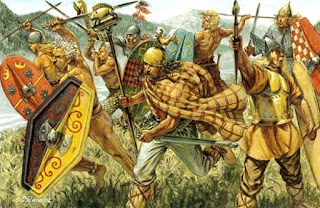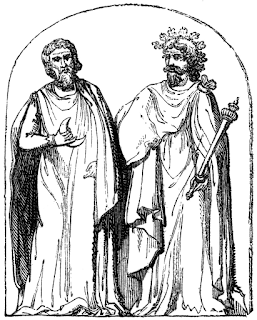The word Celtic became a label for people of north-west Europe, who occupied the territory from the Pyrenees to the Rhine, and from Ireland to Romania. By 600 BC, most of western Europe was occupied by tribes that were thought to be culturally one people.The Greeks named them Keltoi. Greeks and Romans thought of them as a barbarians and considered their nomadic lifestyle uncivilized. Celts left no written records so there is no direct information about them. All we know comes from archaeological discoveries and from writings of classical Mediterranean authors such as Caesar, Pliny, Tacitus and Lucian.
 |
| Celtic warriors |
Archaeological discoveries such as axes, swords, daggers, corn grinding stones and coins show the evidence of ritual activity. Celtic people did not construct permanent temples but probably created sacred enclosures as a focus for ritually damaged votive deposits to be offered to the gods. Many rites may have been performed at sites of natural, religious significance.
Many Graeco-Roman authors were writing about Druids. Druids were Celtic priests, prophets and magicians.
Caesar says that the Druids officiated in the worship of the gods, regulated sacrifices and ruled on religious questions.
 |
| Druids |
Celtic tribes has variety of deities. Weird shaped rocks, gnarled trees, springs and bogs were all places where the gods could be concentrated. Female deities may have had some association with fertility or healing. However, their greatest powers were likely to have been associated with their relationship with a magical otherworld.
The Celts has an oral tradition. Information we have about their believes comes from early Christian monastic scribes from eight and ninth century.
One Irish story is about vengeful goddess Mórrigan. When the hero Cú Chulainn ignores her sexual advances she gets her revenge by trying to distract him while he is engaged in battle with Lóch:
So the Mórrigan came there it the guise of a white red-eared heifer accompanied by 50 heifers...Cú Chulainn made a cast at the Mórrigan and shattered one of her eyes.Then the Mórrigan appeared in the form of a slippery, black eel swimming downstream and went into the pool and coiled herself around Cú Chulainn´s legs...Then the Mórrigan came in the guise of a shaggy russet-colored she-wolf. While Cú Chulainn was warding her off, Lóch wounded him. Thereupon Cú Chulainn was filled with rage and wounded him....and pierced his heart in his breast. A great weariness fell on Cú Chulainn. The Mórrigan appeared to him in the shape of a squint-eyed old woman milking a cow with three teats. He asked her for a drink and she gave him milk from first teat. ´Good health to the giver!´ Cú Chulainn said. ´The blessing of God and man on you.´ And her head was healed and made whole. She gave him milk from second teat and her eye was made whole. She gave him milk from the third teat and her legs were made whole. ´You said you would never heal me,´the Mórrigan said. ´If I´d known it was you I wouldn´t have,´Cú Chulainn said.
 |
| Celtic bard with harp |
There has been much romance build up around Celts. They have been described with characteristics such as chivalry, courage and dauntless bravery. They are viewed as possessing a sensitivity to music and poetry.
Some scholars are pointing to the fact that ´the Celts´ have been romanticized as an ´imagined community´based on a certain shared identity that has more to do with the concerns of modern life than of people who existed more than 2000 years ago.
0 comments:
Post a Comment